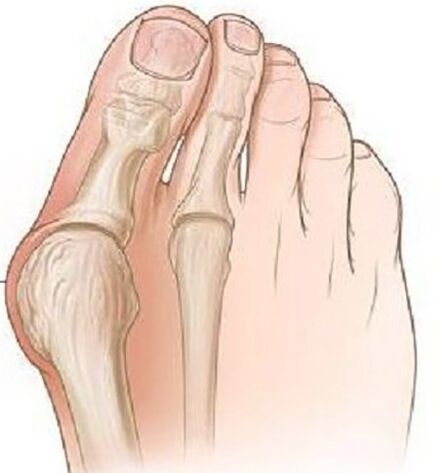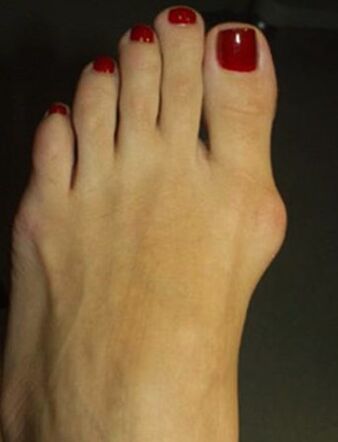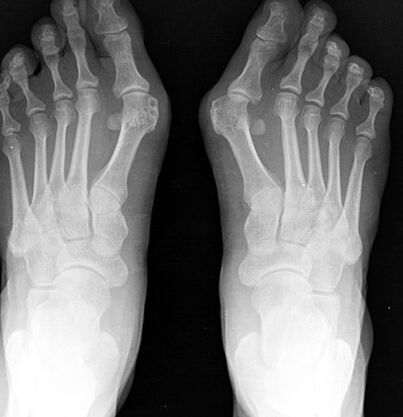Deformation of the thumb valgus of the foot is the most common obtained deformation of the foot, which is characterized by deviation of the thumbs from the outside.
The pathology is natural bilateral, mainly affects women over 35 years old.In most cases, deformation is associated with chronic inflammation of the joint bag and deformation of arthrosis of the nodes plusnephalang, Albanian deviations of the first metatarsal bone.

Causes of the disease.Why is it dangerous?
The etiological causes of the valgus deviations of the toe have not yet been fully studied.There are several theories of occurrence:
- Vestigial theory.In the mid -19th century, it was believed that only models were subjected to this deformation due to the use of model shoes in high jumps, but during the study this pathology was found in men who wore flat shoes.
- The theory of primary muscle weakness - opposed to a detailed study of the problem.
- The theory of the weakness of the ligamentous apparatus and the lack of aponeurosis of the only one - most scientists adhere to this theory.
There are a number of factors that lead to debut of this pathology:
- Excess weight by increasing the load on the foot.
- Age -related dystrophic changes in the articular ligamentous apparatus.
- The weeks of heeled shoes are more than 5 cm, narrowed in the toe.
- Existing skeletal deformities (scoliosis, femur and knee joint valgus deformity, flat feet).
The risk of pathology lies in the fact that over time this deformation leads to behavior deformity, it is possible to develop the dystrophic depth of the spine, hip joints and knee due to improper distribution of loading during walking, and damage to the leg muscles is accompanied by persistent pain, which significantly deteriorate a person.
Clinical manifestations
At the beginning of the disease, valgus deformity does not show itself clinically.Most women are more concerned about the appearance of leg growth in the metacarpal -phalanx joint and the explosion of the first finger becomes visible.

Over time, the pain appears, first when wearing tight shoes and prolonged walking, and later the pain begins to be constant, painful.
Due to the improper distribution of weight, the limbs, from the first and second fingers to the single, formed with corn, the second finger is raised, formed a lot, the "Malleus" fingers are formed, which complicate the walking.Due to the deterioration of blood circulation and intrigue at the front of the foot, arthrosis and chronic bursitis develop.
Troubleshooting
- During an objective examination, the classic deformity with the valgus deviations of the thumb is noticeable, the distal part of the foot expanded.In the projection of the first metatarsal bone, there are signs of bursitis - hyperemia and skin edema, pain during palpation.
- Foot radiography in two projections.The anterior projection determines the degree of thumb, the condition of the metacarpal-palanx joint, the degree of sesamoid bone displacement, and in the side projection the rate of flat legs is visualized and calculated, which often occurs with valgus finger deviations.
- Plantography.In the pressure of the foot, made on paper, a line is drawn through the center of the heel and between the fourth and third fingers, the outer group of the foot is figuratively formed, according to which the presence of flattening of the foot and its grade is estimated.In these patients, a flattened leg or flat foot of 1 degree is most often detected.
Treatment and prevention
Depending on the severity of the process, conservative or surgical treatment is performed.
Conservative treatment is performed in the mild stage of the disease, different types of orthopedic beds are used, which are individually selected and bring the deformed finger to the normal position, while the load on the front of the limbs stabilizes and distributed.
In the age of children and the elderly, the transverse bandage of the distal limbs is used with a laying between the first and second fingers.To reduce the pain, warm baths with sea salt and soda are used, radon baths give a good result.
To combat bursitis, local anti -inflammatory gels are used, Dimexid and lidocain compresses, and with pronounced pain, Novocaine blockade and intraarticular injections of glucocorticoids.

Surgical treatment is possible at any stage of the disease, it is performed under local anesthesia, which reduces the list of contraindications for surgery.
In phase 1, cold bone growths are removed at the inner edge of the bone, while it is only possible to reduce the pain of the process, but not to prevent the development of future deformation.
With a severe finger deviation with the presence of flat feet, an osteotomy is performed at the base of the bone plus of the first finger using a bone blade to reject the finger in the normal position, with the help of a sink ribbon, the transverse ligament of the screen is formed.After surgery, the foot is firmly fixed with a bandage for 4 weeks, it is recommended to use individual orthopedic bedding during the year.
Prevention of the disease is to use comfortable shoes without high heels, shoes should sit freely, a narrow toe should not bring discomfort to the thumb.If there is any skeletal deformity, it is recommended to suffer preventive examinations in the orthopedist in order to identify and slow the progression of the big toe valgus deformation.
Consequences and complications
One complication of the process is the development of deicländer or "march" of the foot, which is characterized by acute pain, due to microcroculation in the paired joints of the foot and tendovaginitis.
Due to the continuous inflammatory process and mechanical damage, there is a risk of developing malignant bone neoplasms.























